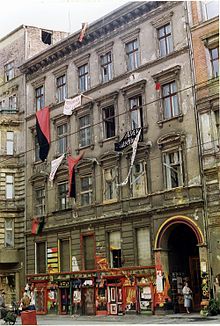Tuntenhaus (Berlin)
The Tuntenhaus in the Berlin district of Prenzlauer Berg is a residential project for homosexuals . It is part of the formerly occupied building at Kastanienallee 86.
history
Bülowstrasse
The first Tuntenhaus in Berlin was founded on February 12, 1981 by occupying Bülowstrasse 55 in the Schöneberg district . It was mainly, but not exclusively, inhabited by homosexual men in shared flats after it had been renovated and expanded on their own. After the CDU's election victory and the evacuation of some occupied houses on September 12, 1981, during which Senator Heinrich Lummer personally inspected occupied houses and the squatter Klaus-Jürgen Rattay died, it was clear that only a few of the 165 houses that had been occupied in the meantime would be legalized. In December 1983 the house was finally cleared and shortly afterwards partially demolished.
Mainzer Strasse
The Tuntenhaus Forellenhof was occupied by homosexual West Berliners on May 1, 1990 at Mainzer Strasse 4 in the Friedrichshain district . It was one of the first occupied houses on Mainzer Strasse. After the house had been renovated in-house with the support of the gay scene in Berlin, around 30 homosexual men finally lived there. The documentary Battle of Tuntenhaus by the American director Juliet Bashore gives an insight into house life at that time . In November 1990 the house - like the rest of Mainzer Straße - was evacuated after fierce street battles between the police and the autonomous community. (see: Clearance of Mainzer Straße ) Bashore's documentation Tuntenhaus-Update reports on the life of former residents after the eviction .
Kastanienallee
After the evacuation, the majority of the residents moved into an occupied house at Kastanienallee 86 in the Prenzlauer Berg district, where the third house in the back of the building is now the third house in Berlin, which, together with the front building, forms an alternative residential project. As was already foreseeable when moving in, the living conditions at Kastanienallee 86 were quickly legalized. In contrast to the project on Mainzer Straße, the follow-up project on Kastanienallee was less politically oriented. Nevertheless, many residents took part in political initiatives such as B. the gay Antifa , the magazine Tuntentinte and the pub h-bar . The annual courtyard festival is also very popular .
In the GDR, the house had been de- rented by the municipal housing administration and was occupied after the fall of the Wall and after many years of vacancy. Shortly afterwards, rental contracts were signed with the housing association Prenzlauer Berg (now: Gewobag ), which is now responsible for the building .
As part of the transfer back in 1999, the house was transferred to a tax advisor from Düsseldorf, who sold it to Kastanienallee 86 GbR in 2004 .
While the Tuntenhaus was located in the rear wing, projects such as the non-commercial Galerie Walden , a food distribution point similar to the Tafel , and a lending and free shop were built in the front building next to the living spaces .
The house is one of the last facilities that have not been affected by the gentrification of Kastanienallee. After the sale in 2004 to Kastanienallee 86 GBR , the three new owners Brauner, Witte and Schlothauer intend to renovate the house. First of all, the attics, where the shared bathrooms are currently located, are to be expanded and offer modern living space to both new tenants and one of the owners themselves. The residents of Kastanienallee 86 protested against the associated rent increases and changed living conditions with, among other things, several rallies and also used neon letters to draw attention to the problem with capitalism, standardized, destroyed, kills on the facade of the front building.
Similar projects
Several similar institutions existed under the name Tuntenhaus . Projects such as the Bremer Tuntenhaus that DerDieDas Tuntenhaus in Bern or the gay and lesbian aunt's house in Geneva , however, no longer exist today. In recent years, however, there have been several squats of mostly homosexual men or women, construction trailer sites and residential projects such as the canal , some of which still exist today.
Web links
- Information about the first queer house
- Kastanienallee 86
- Tuntenhaus - Mainzer Straße ( Memento from July 4, 2008 in the Internet Archive ), Urania Urinowa
- 100.6 Motor FM (MP3; 3.2 MB) radio report from July 12, 2006
- The common concern has been lost . In: Steinschlag , issue 6/2007
- This is our house . In: taz.de , July 11, 2006
- Berlin: Speculation with a house project (K86) . Written by Andrej Holm , November 24th, 2010
- Kastanienallee 86 - Kolberg's breath and hope
Individual evidence
- ↑ Berlin - Memories of a house full of queens ( Memento from October 26, 2004 in the Internet Archive )
- ^ Berlin - Mainzer Strasse, ISBN 3-86163-020-6
- ^ Tuntenhaus Mainzer Straße ( Memento from July 4, 2008 in the Internet Archive )
- ↑ GB , 1990, 60 min.
- ↑ GB, 1992, 45 min.
- ↑ Leihladen Leila in Kastanienallee 86
Coordinates: 52 ° 32 ′ 15.3 " N , 13 ° 24 ′ 33.7" E

